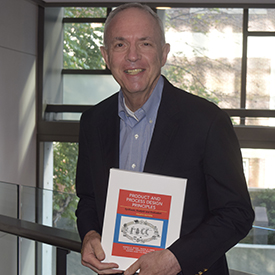Warren Seider Authors Product and Process Design Principles Textbook
 The Fourth Edition of Product and Process Design Principles by Chemical and Biomolecular Engineering Professor Warren Seider and his colleagues Daniel R. Lewin, J.D. Seader, Soemantri Widagdo, Rafiqul Gani, and Ka M. Ng was recently published by John Wiley & Sons.
The Fourth Edition of Product and Process Design Principles by Chemical and Biomolecular Engineering Professor Warren Seider and his colleagues Daniel R. Lewin, J.D. Seader, Soemantri Widagdo, Rafiqul Gani, and Ka M. Ng was recently published by John Wiley & Sons.
Since the textbook was first published in 1998, over 40,000 copies have been sold worldwide.
“When we wrote the first edition, there was a need for a book that married modern strategies for process synthesis with process simulation and economic analysis – placing more emphasis on computational methods”. Gradually we added material on the innovation of chemical products – showing the importance of designing processes that manufacture them. Initially, we focused on multimedia software to help teach the basics of process simulators. For our Fourth Edition, the electronic PDF file appears to be the most popular – accompanying our multimedia teaching materials and the website that John Wiley maintains for our book.
A principal objective of this updated Fourth Edition is to describe modern strategies for the design of chemical products and processes, with an emphasis on a systematic approach. This fourth edition presents two parallel tracks: (1) product design, and (2) process design, with emphasis on process design. Process design instructors can show easily how product designs lead to new chemical processes. Alternatively, product design can be taught in a separate course – following the process design track in an earlier course.
The fourth edition provides Introductory Part One – with a broad, but brief, introduction to product design that all design students should read. This is accompanied by a comprehensive introduction to process design; i.e., process synthesis and analysis. A complete chapter brings broad, also brief, coverage of energy sources, environmental issues, sustainability, safety, and engineering ethics – all applied throughout the book. Part Two is on design synthesis – with two product design chapters, on molecular and mixture design, and on chemical devices, functional products, and formulated products – and 10 process design chapters, on heuristics, process simulation, algorithmic methods for process synthesis, and equipment design. It finishes with comprehensive chapters on capital cost estimation [including the Aspen Process Economic Analyzer (APEA)] and profitability analysis (including an EXCEL spreadsheet). Part Three focuses on product and process analysis, Part Four on design reports, and Part Five presents four design case studies.
Two web sites augment the text with: supplemental chapters, in PDF files, from earlier editions; program and simulation files that solve 60 example problems, a solution manual for homework exercises, 93 design problem statements, and multimedia courseware that uses voice, video, and animation to introduce new users of the steady-state simulators to the specifics of two of the most widely used process simulation programs, ASPEN PLUS and HYSYS (UniSim Design). Also, Chapter 15 introduces tubular and stirred tank reactor design using COMSOL CFD.
Electronic copies of the textbook can be seen here: http://www.wiley.com/WileyCDA/WileyTitle/productCd-1119257336.html?filter=TEXTBOOK.
Printed copies can be purchased from the Penn Bookstore.
